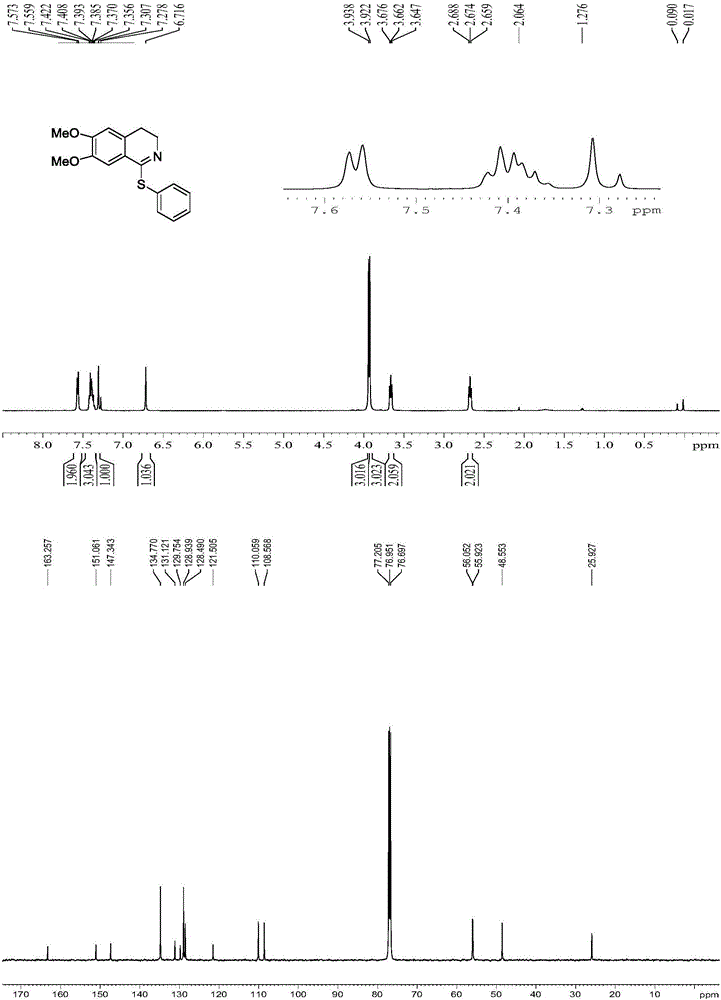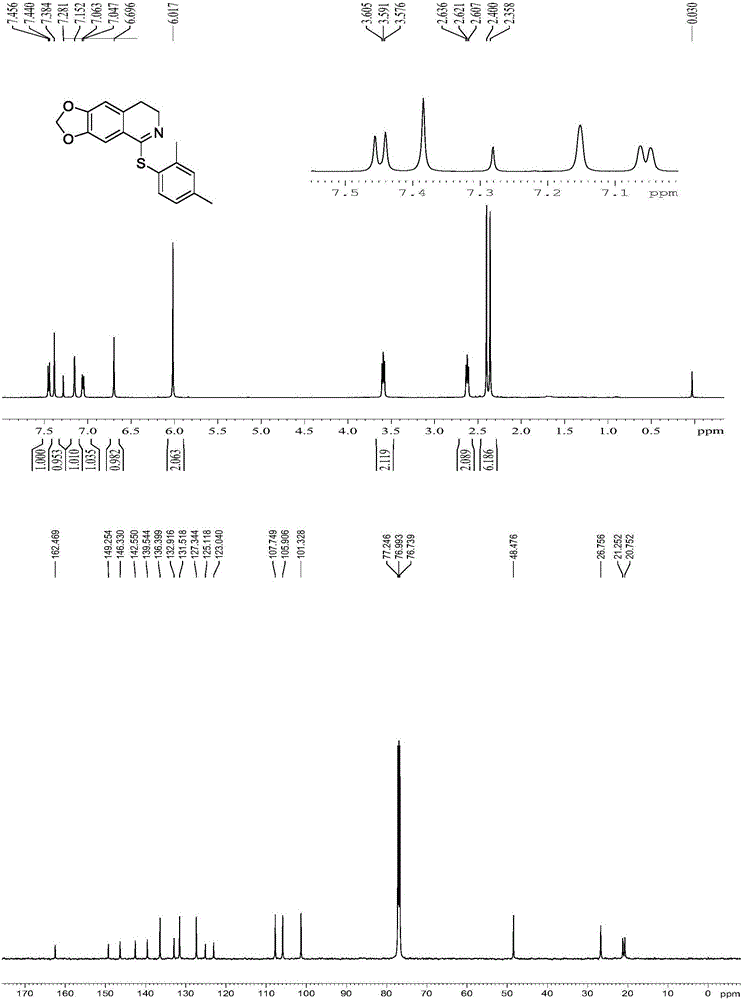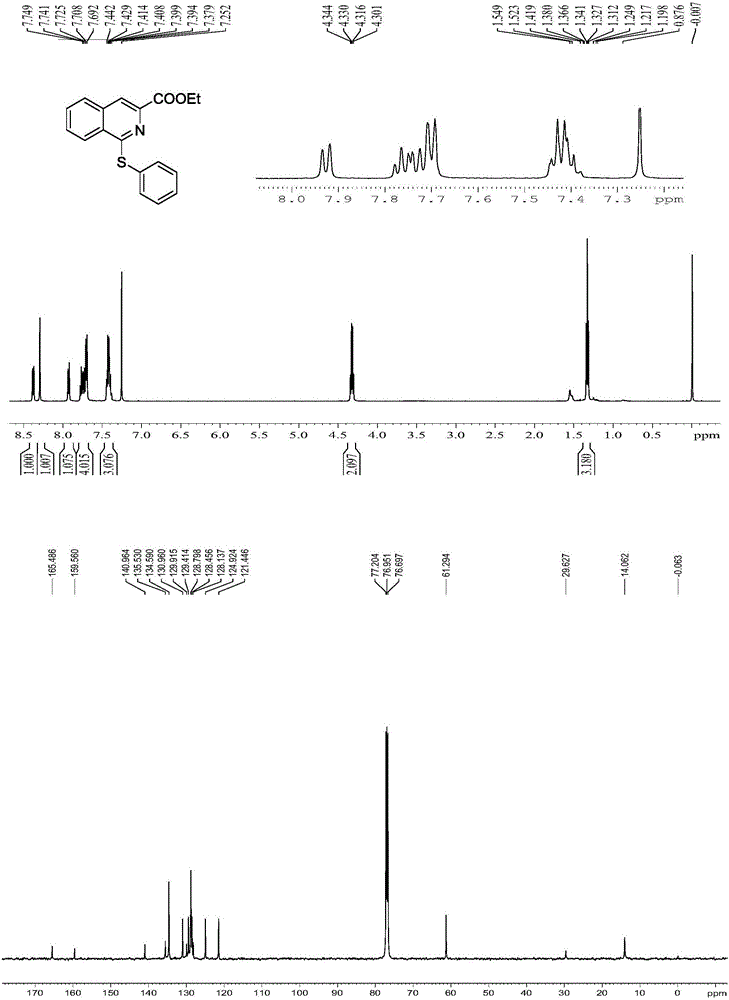Preparation method for polysubstituted isoquinoline derivative
A derivative and multi-substitution technology, which is applied in the field of preparation of multi-substituted isoquinoline derivatives, can solve the problems of high production cost, large environmental pollution, cumbersome synthesis steps, etc., achieve high yield, scientific and reasonable synthesis method, and comprehensive The effect of simple method
- Summary
- Abstract
- Description
- Claims
- Application Information
AI Technical Summary
Problems solved by technology
Method used
Image
Examples
Embodiment 1
[0030] Preparation of isoquinoline derivative 3a
[0031]
[0032] Into a 10ml reactor, add isothiocyanate 1a (0.4mmol, 89.2mg), diaryl hypervalent iodide 2a (0.6mmol, 255.6mg), cuprous chloride (0.04mmol), and replace nitrogen three times Finally, dichloroethane (2ml) was added, and after the addition was completed, the reaction was carried out at 80°C for 1.5h. After the reaction system was cooled, 5 ml of saturated sodium bicarbonate solution was added to quench the reaction, and extracted three times with 30 ml of ethyl acetate. The organic phases were combined, dried by adding magnesium sulfate for 30 minutes, filtered, and the filtrate was concentrated by rotary evaporation to obtain a crude product. The crude product was separated by eluent column (200-300 mesh silica gel), and the white solid product was confirmed to be isoquinoline derivative 3a by NMR and HRMS, and the yield was 90%.
[0033] Spectrum analysis data 3a:
[0034] 1 H NMR (CDCl 3 ,500MHz): δ2.68(...
Embodiment 2
[0036] Replace 2a in Example 1 with 2b, and other experimental conditions are the same as Example 1. The experimental results are shown in Table 1.
[0037]
[0038] Spectrum analysis data 3b:
[0039] 1 H NMR (CDCl 3 ,500MHz): δ2.36(s,3H),2.65(t,J=7.4Hz,2H),3.64(t,J=7.2Hz,2H),3.91(s,3H),3.92(s,3H) ,6.69(s,1H),7.21(d,J=7.9Hz,2H),7.30(s,1H),7.43(d,J=8.0Hz,2H). 13 C NMR (CDCl 3 ,125MHz):δ21.3,26.0,48.6,56.0,56.1,108.4,110.0,121.6,125.9,130.0,131.1,135.0,138.8,147.3,151.0,163.5.HRMS(ESI-TOF,[M+H] + ):Calcd for C 18 h 19 NO 2 S, 313.1262; Found, 313.1265.
Embodiment 3
[0041] Replace 2a in Example 1 with 2c, and other experimental conditions are the same as Example 1, and the experimental results are shown in Table 1.
[0042]
[0043] Spectral analysis data 3c:
[0044] 1 H NMR (CDCl 3,500MHz):δ2.65(t,J=7.4Hz,2H),3.63(t,J=7.2Hz,2H),3.92(s,3H),3.93(s,3H),6.70(s,1H) ,7.09(t,J=8.6Hz,2H),7.28(s,1H),7.51-7.54(m,2H). 13 C NMR (CDCl 3 ,125MHz): δ26.0,48.6,56.0,56.1,108.3,110.1,116.2(d,J C-F =21.94Hz), 121.5, 124.6, 131.1, 137.2 (d, J C-F =248.34Hz),147.4,151.2,162.1,163.1,164.0.HRMS(ESI-TOF,[M+H] + ): Calcd for C 17 h 16 FNO 2 S, 317.1012; Found, 317.1015.
PUM
 Login to View More
Login to View More Abstract
Description
Claims
Application Information
 Login to View More
Login to View More - R&D
- Intellectual Property
- Life Sciences
- Materials
- Tech Scout
- Unparalleled Data Quality
- Higher Quality Content
- 60% Fewer Hallucinations
Browse by: Latest US Patents, China's latest patents, Technical Efficacy Thesaurus, Application Domain, Technology Topic, Popular Technical Reports.
© 2025 PatSnap. All rights reserved.Legal|Privacy policy|Modern Slavery Act Transparency Statement|Sitemap|About US| Contact US: help@patsnap.com



